Abstract
OBJECTIVES: To determine the current status of electronic fetal monitoring (EFM) in Canadian teaching and nonteaching hospitals, to review the medical and nursing standards of practice for EFM and to determine the availability of EFM educational programs. DESIGN: National survey in 1989. PARTICIPANTS: The directors of nursing at the 737 hospitals providing obstetric care were sent a questionnaire and asked to have it completed by the most appropriate staff member. The response rate was 80.5% (593/737); 44 hospitals did not have deliveries in 1988 and were excluded. The remaining hospitals varied in size from 8 to 1800 (mean 162.1) beds and had 1 to 7500 (mean 617.1) births in 1988; 18.8% were teaching hospitals. RESULTS: Of the 549 hospitals 419 (76.3%) reported having at least 1 monitor (range 1 to 30; mean 2.6); the mean number of monitors per hospital was higher in the teaching hospitals than in the nonteaching hospitals (6.2 v. 1.7). Manitoba had the lowest mean number of monitors per hospital (1.1) and Ontario the highest (3.7). In 71.8% of the hospitals with monitors almost all of the obstetric patients were monitored at some point during labour. However, 21.6% of the hospitals with monitors had no policy on EFM practice. The availability of EFM educational programs for physicians and nurses varied according to hospital size, type and region. CONCLUSIONS: Most Canadian hospitals providing obstetric services have electronic fetal monitors and use them frequently. Although substantial research has questioned the benefits of EFM, further definitive research is required. In the meantime, a national committee should be established to develop multidisciplinary guidelines for intrapartum fetal assessment.
Full text
PDF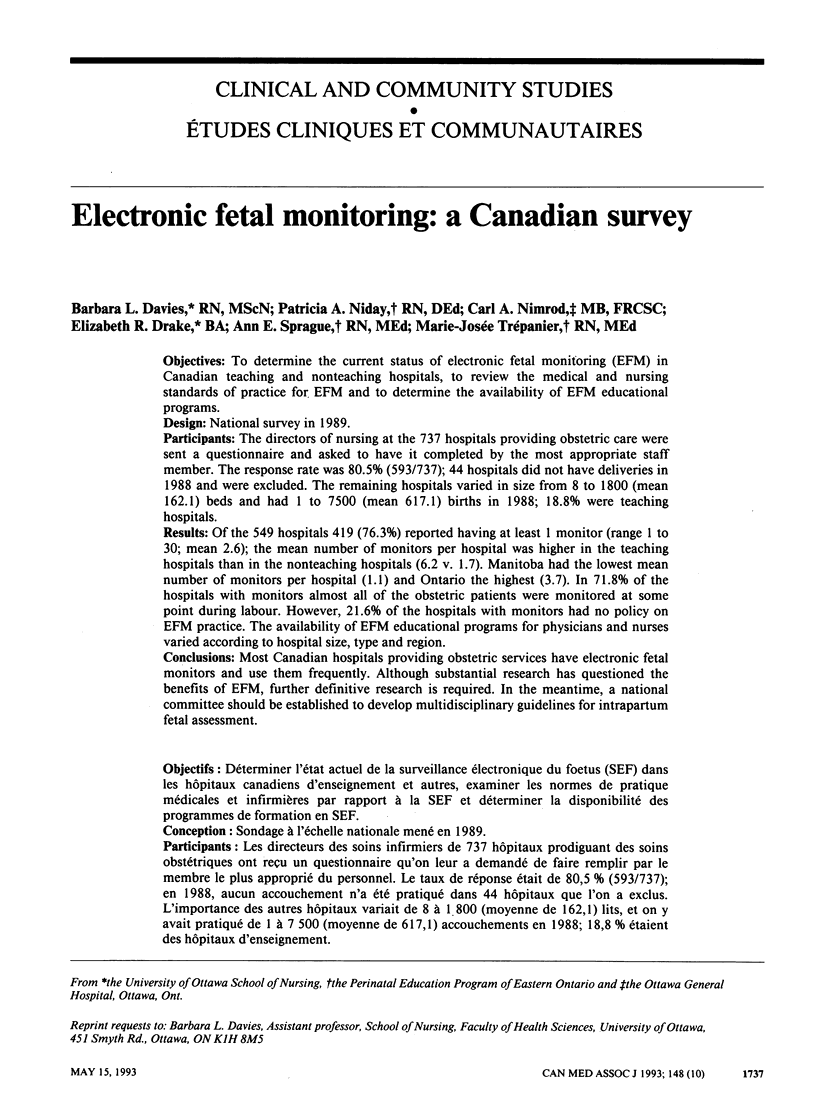
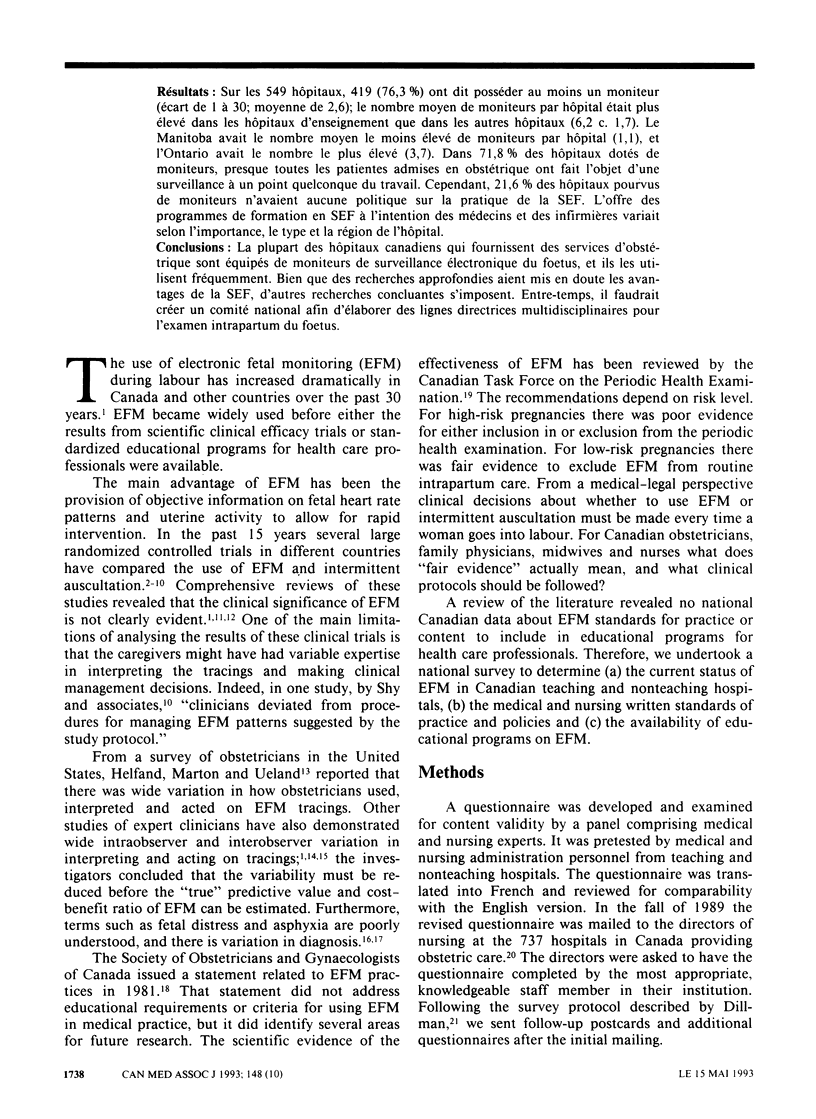
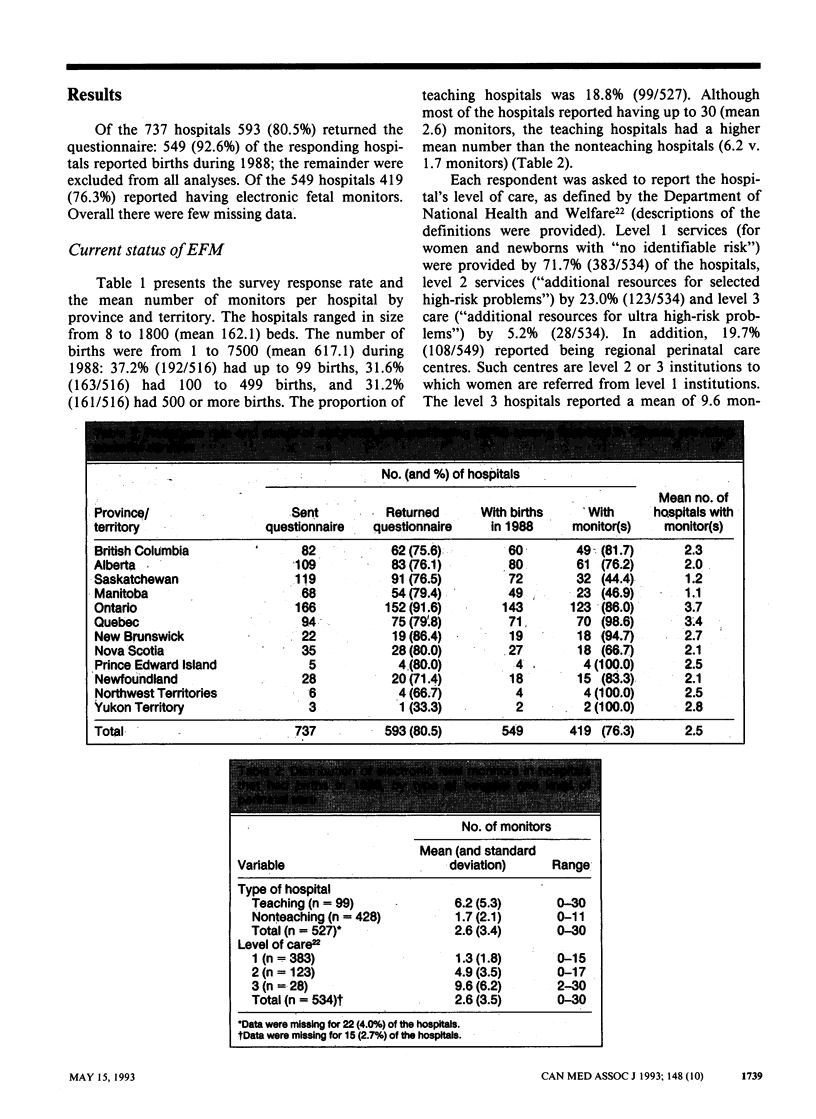
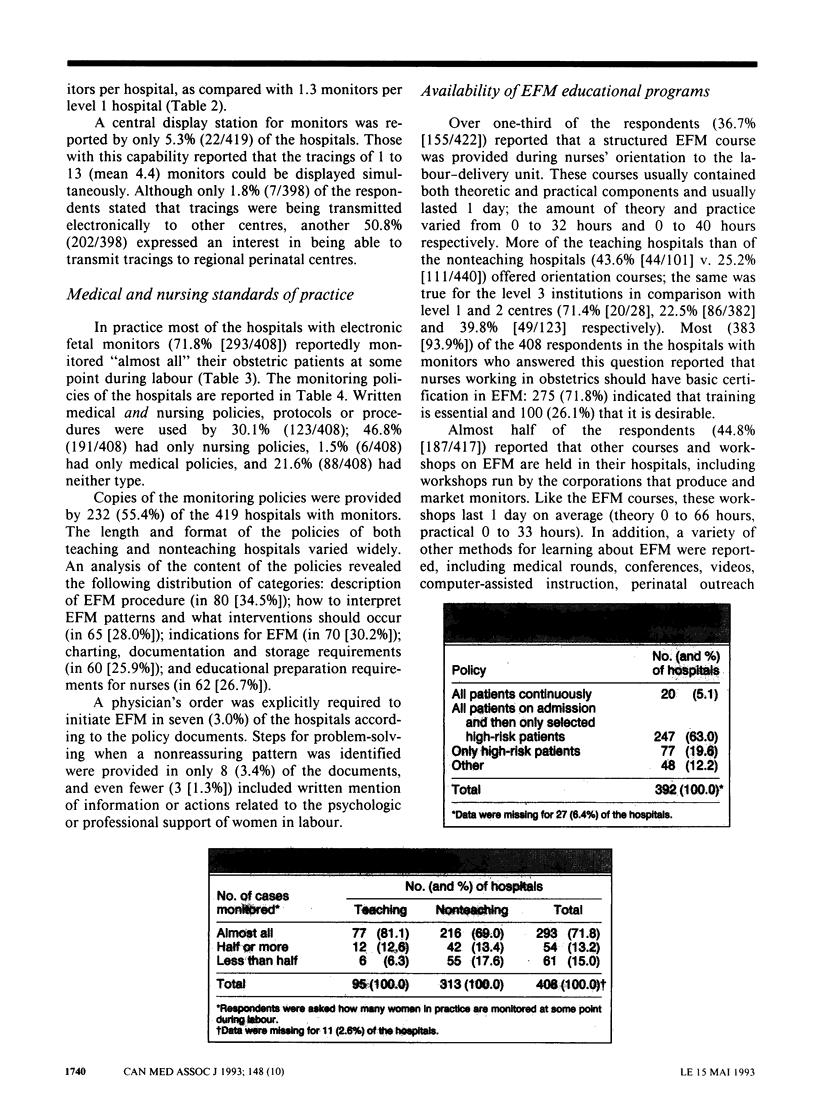
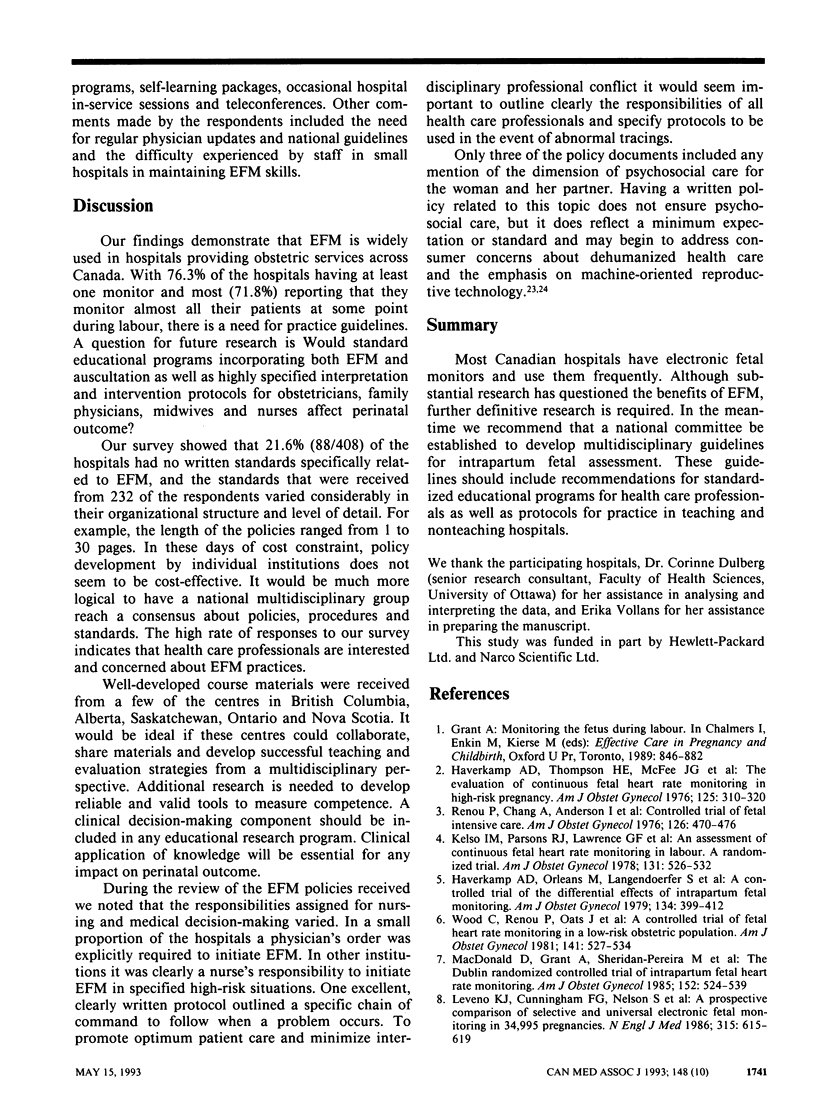
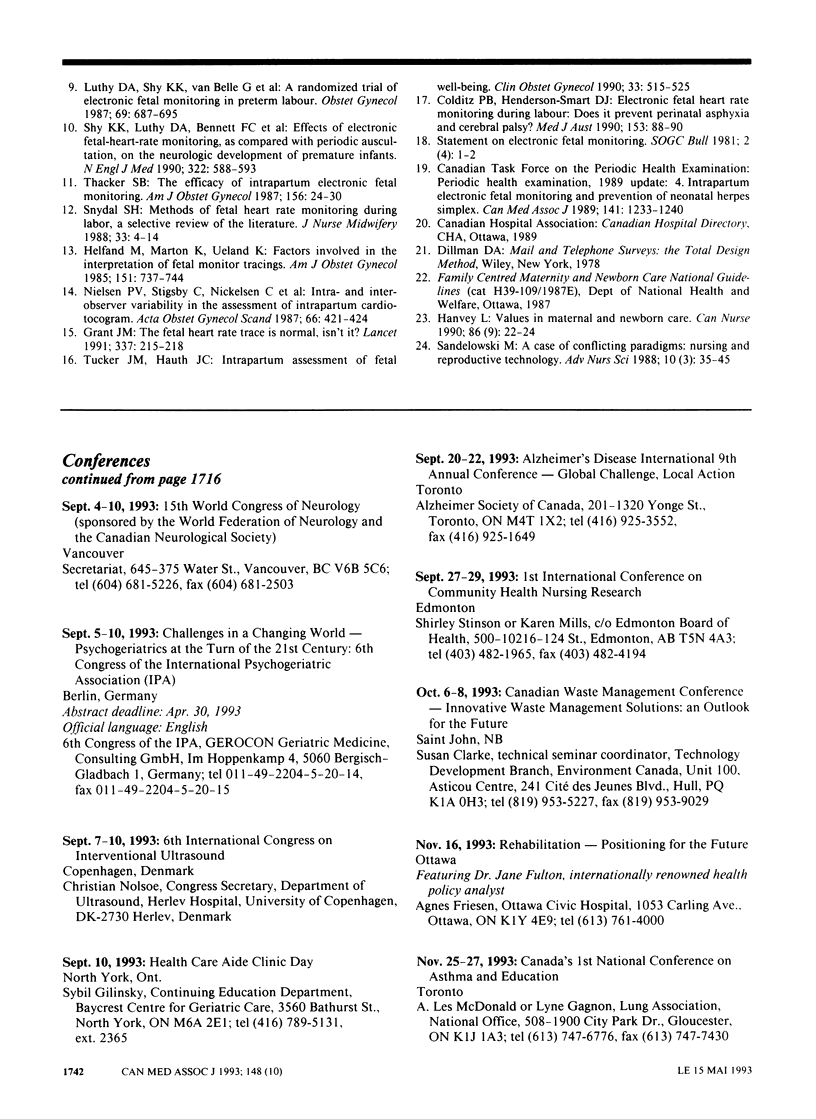
Selected References
These references are in PubMed. This may not be the complete list of references from this article.
- Colditz P. B., Henderson-Smart D. J. Electronic fetal heart rate monitoring during labour: does it prevent perinatal asphyxia and cerebral palsy? Med J Aust. 1990 Jul 16;153(2):88–90. doi: 10.5694/j.1326-5377.1990.tb136798.x. [DOI] [PubMed] [Google Scholar]
- Grant J. M. The fetal heart rate trace is normal, isn't it? Observer agreement of categorical assessments. Lancet. 1991 Jan 26;337(8735):215–218. doi: 10.1016/0140-6736(91)92169-3. [DOI] [PubMed] [Google Scholar]
- Hanvey L. Values in maternal and newborn care. Can Nurse. 1990 Oct;86(9):22–24. [PubMed] [Google Scholar]
- Haverkamp A. D., Orleans M., Langendoerfer S., McFee J., Murphy J., Thompson H. E. A controlled trial of the differential effects of intrapartum fetal monitoring. Am J Obstet Gynecol. 1979 Jun 15;134(4):399–412. doi: 10.1016/s0002-9378(16)33082-4. [DOI] [PubMed] [Google Scholar]
- Haverkamp A. D., Thompson H. E., McFee J. G., Cetrulo C. The evaluation of continuous fetal heart rate monitoring in high-risk pregnancy. Am J Obstet Gynecol. 1976 Jun 1;125(3):310–320. doi: 10.1016/0002-9378(76)90565-2. [DOI] [PubMed] [Google Scholar]
- Helfand M., Marton K., Ueland K. Factors involved in the interpretation of fetal monitor tracings. Am J Obstet Gynecol. 1985 Mar 15;151(6):737–744. doi: 10.1016/0002-9378(85)90507-1. [DOI] [PubMed] [Google Scholar]
- Kelso I. M., Parsons R. J., Lawrence G. F., Arora S. S., Edmonds D. K., Cooke I. D. An assessment of continuous fetal heart rate monitoring in labor. A randomized trial. Am J Obstet Gynecol. 1978 Jul 1;131(5):526–532. doi: 10.1016/0002-9378(78)90114-x. [DOI] [PubMed] [Google Scholar]
- Leveno K. J., Cunningham F. G., Nelson S., Roark M., Williams M. L., Guzick D., Dowling S., Rosenfeld C. R., Buckley A. A prospective comparison of selective and universal electronic fetal monitoring in 34,995 pregnancies. N Engl J Med. 1986 Sep 4;315(10):615–619. doi: 10.1056/NEJM198609043151004. [DOI] [PubMed] [Google Scholar]
- Luthy D. A., Shy K. K., van Belle G., Larson E. B., Hughes J. P., Benedetti T. J., Brown Z. A., Effer S., King J. F., Stenchever M. A. A randomized trial of electronic fetal monitoring in preterm labor. Obstet Gynecol. 1987 May;69(5):687–695. [PubMed] [Google Scholar]
- MacDonald D., Grant A., Sheridan-Pereira M., Boylan P., Chalmers I. The Dublin randomized controlled trial of intrapartum fetal heart rate monitoring. Am J Obstet Gynecol. 1985 Jul 1;152(5):524–539. doi: 10.1016/0002-9378(85)90619-2. [DOI] [PubMed] [Google Scholar]
- Nielsen P. V., Stigsby B., Nickelsen C., Nim J. Intra- and inter-observer variability in the assessment of intrapartum cardiotocograms. Acta Obstet Gynecol Scand. 1987;66(5):421–424. doi: 10.3109/00016348709022046. [DOI] [PubMed] [Google Scholar]
- Renou P., Chang A., Anderson I., Wood C. Controlled trial of fetal intensive care. Am J Obstet Gynecol. 1976 Oct 15;126(4):470–476. doi: 10.1016/0002-9378(76)90641-4. [DOI] [PubMed] [Google Scholar]
- Sandelowski M. A case of conflicting paradigms: nursing and reproductive technology. ANS Adv Nurs Sci. 1988 Apr;10(3):35–45. doi: 10.1097/00012272-198804000-00005. [DOI] [PubMed] [Google Scholar]
- Shy K. K., Luthy D. A., Bennett F. C., Whitfield M., Larson E. B., van Belle G., Hughes J. P., Wilson J. A., Stenchever M. A. Effects of electronic fetal-heart-rate monitoring, as compared with periodic auscultation, on the neurologic development of premature infants. N Engl J Med. 1990 Mar 1;322(9):588–593. doi: 10.1056/NEJM199003013220904. [DOI] [PubMed] [Google Scholar]
- Snydal S. H. Methods of fetal heart rate monitoring during labor. A selective review of the literature. J Nurse Midwifery. 1988 Jan-Feb;33(1):4–14. doi: 10.1016/0091-2182(88)90243-1. [DOI] [PubMed] [Google Scholar]
- Thacker S. B. The efficacy of intrapartum electronic fetal monitoring. Am J Obstet Gynecol. 1987 Jan;156(1):24–30. doi: 10.1016/0002-9378(87)90197-9. [DOI] [PubMed] [Google Scholar]
- Tucker J. M., Hauth J. C. Intrapartum assessment of fetal well-being. Clin Obstet Gynecol. 1990 Sep;33(3):515–525. doi: 10.1097/00003081-199009000-00017. [DOI] [PubMed] [Google Scholar]
- Wood C., Renou P., Oats J., Farrell E., Beischer N., Anderson I. A controlled trial of fetal heart rate monitoring in a low-risk obstetric population. Am J Obstet Gynecol. 1981 Nov 1;141(5):527–534. doi: 10.1016/s0002-9378(15)33273-7. [DOI] [PubMed] [Google Scholar]


